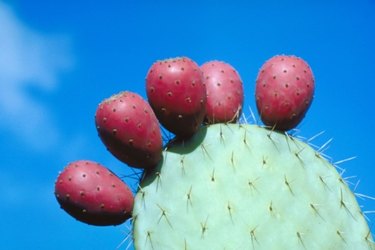
The prickly pear cactus is known by several names. In Spanish, the flat, fleshy leaves are called "nopales." In Mexico, the tube-shaped fruit that grows at the top of the plant is called the "tuna," or "Indian fig." It is the only member in the genus, Opuntia, although there are more than 300 varieties, most of which grow in throughout the Americas. The plant is versatile, with uses ranging from culinary to medicinal.
Culinary Uses
Video of the Day
The leaves and fruit of the prickly pear cactus are edible and are common additions to indigenous foods of Mexico and American Indian cuisine. The pad, which is the flat, oval part of the cactus, tastes like green beans. You can eat it raw, cooked or skinned and jellied. Indigenous people traditionally used the seeds in soups, or dried and ground into a flour. The fruit of the cactus is the portion that has a pink, tube-like appearance. Depending on the variety of prickly pear you choose, the fruit will taste like strawberries, melon or citrus. The fruit is a good for jams, jellies, or eaten raw. In Mexico, you might find cactus fruit candies. Fermented, the fruit makes a sweet alcoholic beverage, or dried and powdered, it makes a sweet pastry.
Video of the Day
Medicinal Uses
The sticky gel-like substance from the pad of the prickly pear cactus has similar healing properties as the aloe vera plant. For sunburns or other types of burns and cuts, slice open a pad, squeeze out the juice and apply to the wound. Medical studies have shown that certain varieties of the cactus may prove useful in the treatment of diabetes, such as the Opuntia streptacantha cultivar. The Opuntia fidicus-indica "Indian fig" may help reduce the severity of hangovers, while other medical studies have noted its ability to reduce nausea, dry mouth and loss of appetite as a result of overconsumption of alcohol and hangover.
Livestock Drought Feed
During times of drought, prickly pear cactus is a lifesaver for livestock. Because the plant grows in abundance throughout the American Southwest and in other dry climates, it is easy to find and harvest with proper safety precautions. The fruit and pads are most succulent during the springtime, but they are full of water and nutrients any time of year. After harvesting the cacti, either remove the sharp needles or chop them up with the cactus to prevent livestock from sustaining injuries while eating. Some of the newer varieties of the plant have smaller or fewer thorns. The prickly pear cactus imbues the milk of dairy cows with a distinct flavor that is desirable in some communities in Mexico.
Other Uses
If you live in an area that is dry and prone to animal predators, the prickly pear cactus makes a good fence-like barrier. Its long, sharp needles deter most animals larger than rabbits. Plant them a foot apart to allow for growth and they will become an effective fence. In Central Africa, the sap from the needle pads has been used as a mosquito repellent. The sap is also good for making chewing gum and candles. It is also sometimes used as a stiffening agent in the manufacture of cotton cloth. Prior to the reliance on synthetic dyes, the Opuntia streptacantha fruit was a major ingredient in food colorings. The red fruits contain betacyanins, which are red pigments found in several plants, fruits and vegetables. You can also dry and pound the pads to extract the fibrous strings. These are useful for making baskets, fans, fabrics and paper.